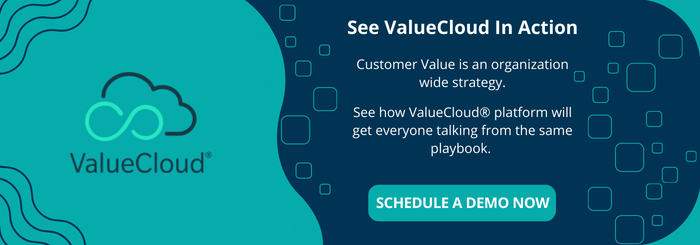The Disappearing Traditional Sales Process

The SaaS space is booming. It is expected that the number of SaaS companies is going to grow exponentially around the world within the next five years. And these SaaS companies have one thing in mind: to make doing business easier and more convenient. Software in general removes manual processes, accelerates scaling, and enables users to be focused on much more valuable activities. Part of the simplification of business is also to make solutions much more accessible, transparent, and easy to buy. In 2015, a blog post on Forbes based on a Gartner analysis reported that 57% of the traditional sales process had disappear due to digitalization and the power of software. Fast forward 7 years, I posit that more than 60 to 65% of traditional selling activities have vanished to give space to automated and transparent information searches.
Would you like to see ValueCloud in action? Book a no-obligation demo now.
There is no doubt that software is taking over the world! It is disrupting traditional selling methodologies, accelerating supply chains, and revolutionizing the sales function. Investments in the SaaS world are pouring in. Outside the SaaS world, traditional companies are also investing increasingly in software solutions in traditional categories (CRM, ERP, engineering) but also emerging digital ones (sales enablement, customer data platform, AI, and customer value management).
“More accurately, 57% of the sales process just disappeared. What are buyers doing if they are not talking to sales? They are surfing corporate websites to identify and qualify vendors, instead of the sales force qualifying them. They are engaging peers in social media to learn more about their needs, potential solutions and providers.” 1
The sales process as we knew it 5-10 years ago has disappeared for a variety of reasons. I propose that there are forces both from the vendor and buyer perspective that have tremendously changed the sales function and the process of selling. Let us look at them.
FROM THE VENDOR’S PERSPECTIVE:
- Self-service Business Models: Companies have focused on offering simple and convenient solutions to consumers who do not want to interact with a seller. The ability to buy directly online combined with low-touch support has removed the need to call a sales rep or an agent to do business.
- Direct-to-Consumer Business Models: B2B companies have adopted direct-to-consumer models making it easier for consumers to purchase through e-commerce platforms; thus, bypassing the distribution intermediaries and the need to make a phone to sales professionals or a sales desk.
- CPQ Technology: Sales professionals no longer need to carry their pads, pens, and calculators. The booming CPQ category has accelerated the speed and quotation process removing hours of manual activities and unnecessary delays.
- Digital Selling Technology: More of the sales process has moved to the virtual world using smart selling platforms that connect directly to CRM, CPQ, and marketing automation platforms. The on-going health crisis has exacerbated this trend.
- The Emergence of New Sales Support Roles: Back in the day, we used to call inside sales, customer service, or your friendly sales representative to do business. Today, new roles have emerged to support the selling process both in pre-sales and post sales. For example, sales development reps focus on qualifying prospects so the account managers can perform more valuable work. Customer success managers focus on retention, up-selling, and on renewal. All that to say, selling is more a team sport than ever.
Similarly, investments and disruption in the procurement space have disrupted the traditional sales process. Forces from the BUYER’S PERSPECTIVE include:
- Marketplace and Platforms: A lot of the simple, off-the-shelf, repetitive purchases have moved to online trading platforms that are more user-friendly and mobile-friendly.
- Procurement Automation: Evolution in procurement software have automated most of the search, qualification, and decision-making steps. This alone replaced a sizable portion of the traditional sales activities done by sales reps who were simple order-takers.
- E-cataloging Technology: Closely related to forces 1 and 2, vendors are required to be referenced and to submit all proper documents to be included in a procurement platform. That might happen through platforms directly or through web site plugins thus removing the need for sales reps to get involved.
- Independent Performance Ratings: Procurement professionals look for sources of independent information on vendor performance but also on the quality of their offers. They rely on analysts reports, quadrant positioning, independent ratings, published reports to evaluate vendors’ performance levels. They have a tendency not to believe information supplied by vendors. They often disqualify vendors who are not rated well by industry peers or independent groups.
- TCO and ROI analysis: Similarly, buyers will conduct their own total cost of ownership comparing solutions and products they procure. They might ask for business value assessments and ROI calculations from their vendors, but they will spend some time validating these and doing their homework.
Who would have predicted such a revolution in the way the sales function operated? If 60 to 65% of the traditional sales process is no longer needed and you have not changed your sales process, what are your sellers doing all day? Sales as we once knew it as is dead. The new sales role is focused on the rest of the 40%, which includes account management, consultative selling, customer value management, and other high-value activities.
The value your product or service delivers to customers is one of your most important assets. Elevate your sales strategy.
1 The Disappearing Sales Process (forbes.com)
Bio

Dr. Stephan Liozu (www.stephanliozu.com) is the Founder of Value Innoruption Advisors (www.valueinnoruption.com), a consulting boutique specializing in industrial pricing, digital business, and value models, and value-based pricing. Stephan has 30 years of experience in the industrial and manufacturing sectors with companies like Owens Corning, Saint-Gobain, Freudenberg, and Thales. He holds a Ph.D. In Management from Case Western Reserve University, and has written several books, including “Dollarizing Differentiation Value” (2016) and “Value Mindset” (2017).

 ValueCloud
ValueCloud
.png?width=118&height=76&name=Rectangle%20(3).png) ValueCloud Ignite
ValueCloud Ignite
.png?width=92&height=92&name=Rectangle%20(4).png) Free Assessment
Free Assessment
.png?width=100&height=100&name=Rectangle%20(5).png) Watch a Demo
Watch a Demo
.png?width=82&height=96&name=Rectangle%20(6).png) Value Calculator
Value Calculator

.png?width=62&height=51&name=Group%2010%20(1).png) Marketing
Marketing
 Sales
Sales
 Customer Success
Customer Success
 Engage Prospects
Engage Prospects
 Win Deals Faster
Win Deals Faster
 Retain Customers
Retain Customers
.png?width=62&height=62&name=Rectangle%20(8).png) Adopt and Scale
Adopt and Scale
.png?width=54&height=54&name=Rectangle%20(9).png) Cybersecurity
Cybersecurity
 Healthcare
Healthcare
.png?width=54&height=54&name=Rectangle%20(10).png) IT & Software
IT & Software




